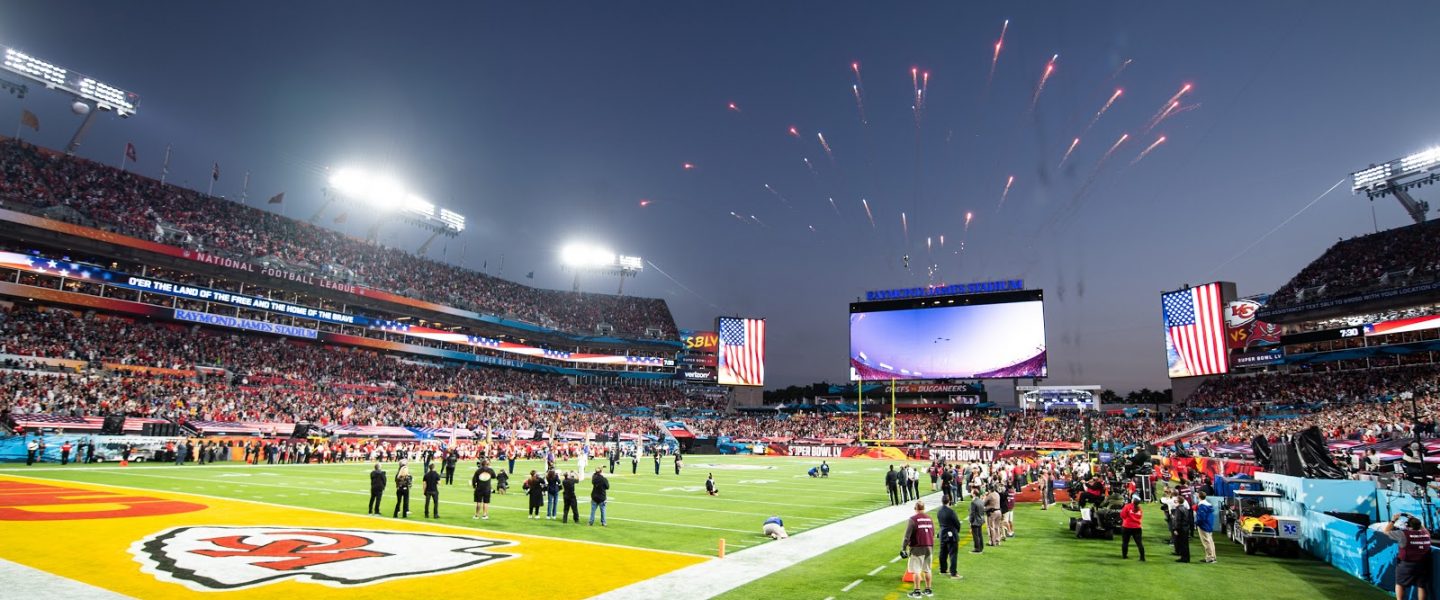Look — up in the sky! It’s long-term taxpayer investment in nuclear annihilation!
|
Listen To This Story
|
In tight formation over the Super Bowl, low enough for their engines’ wails to be heard over the crooning of the national anthem and the noise of the 25,000 people in socially distanced attendance, flew the deadliest airplanes the world has ever known — the three heavy strategic bombers flown by the United States Air Force.
In the works for more than a year, the power and the glory on display was enough, perhaps, to make us forget for a moment that these jets were flying over a country ravaged and ransacked by a virus that has killed 500,000 people and counting. Over a country that cannot deliver $1,400 checks in an economic crisis, or guarantee health care to its citizens in a public health crisis, flew aircraft designed solely to deliver a nuclear weapon anywhere in the world, upon anyone in the world. If this was an impressive metaphor, it was also a grotesque one, the costliest preening in the history of the NFL — the most expensive “touchdown dance” in the history of the sport.
https://twitter.com/DeptofDefense/status/1358566514815889413
A Commercial Years in the Making
Military pageantry and a strong-yet-superficial ethos of supporting the troops have been part of the National Football League’s product for a long time. (What it actually means to “support troops” is a difficult and thorny question, and so it is seldom asked nor answered.) But the seconds-long glimpse of a Rockwell B1B-Lancer, a Northrop Grumman B-2 Spirit (better known as the “stealth bomber”), and a Boeing B-52 Stratofortress flying together in the sky low over Raymond James Stadium was something new, for both members of the NFL-military industrial partnership: This was the first time that this nuclear triad has appeared in unison over any sporting event, the Department of Defense proudly noted.
It has been decades since there were nuclear-armed B-52s in the air at all times (though some return towards this posture is a possibility, Air Force brass has hinted recently). And the B1 is no longer considered “nuclear capable,” and has been relegated from deterring Moscow to bombing runs over shepherds in Helmand Province, Afghanistan. But putting all three strategic bombers in the air at the same time, right in the public’s face, is still a very serious flex.
The Pentagon has wanted to do it for a while, apparently. “The bomber trifecta flyover is something that Carla Pampe, the AFGSC chief of civic outreach, had been pitching to us for about four years, and this year it worked out for us to do it,” said Katie Spencer, who is the sports outreach program manager and aerial events coordinator for the Air Force Public Affairs Office.
Planning for the flyover began last March, before the pandemic killed more Americans than died in Vietnam or World War II. The flyover survived the pandemic, even if your job, your savings, or someone you know did not. 2021 was just the year it worked out for the Air Force to do it.
Just Part of the Deal
It costs $140,000 to fly a B-2 for an hour; flight time for a B-52 is about half that. The Pentagon’s budget is $740.5 billion and 4,500 pages long. (Consider that these planes would not exist as-is if not for the nuclear weapons program, which Brookings estimated cost $5.8 trillion through 1996.) As for the flyover? Granular details like these don’t appear in budget line items, and the Air Force did not offer an estimate.
In a preemptive strike to the predictable complaints, the war machine’s apologists rebut that flyovers are included in the base budget. They argue that these are training flight hours that the Air Force would be doing anyway. That is hard to square with the Pentagon eagerly listing all the special work the super flyover required: Deploying airmen and ground crews from across the country to Tampa, flying practice runs to make sure the whole thing went off without a hitch, hundreds more working at three different airbases, in-flight refueling — costly logistics not broadcast, but that the Air Force thinks are well worth it and that Americans are simply gonna love.
From the Air Force via Bossier Now, the outlet covering Barksdale:
“One of the reasons we do flyovers in the Air Force is to inspire patriotism and future generations of aviation enthusiasts, and our aircrew and maintainers are great messengers to share the Air Force story,” said Jennifer Bentley, chief of policy and public outreach for the Secretary of the Air Force Public Affairs Office. “This is also an amazing way to showcase the capabilities of our aircraft to the American public.” …
“As the bombers soar over Super Bowl LV this year, the public will see a showcase of American airpower, and hopefully feel inspired and proud,” she said. “But this flyover is also a testament to the hundreds of Airmen and civilians behind the scenes who worked months and long hours to make it happen.”
Nuclear-Adjacent War
Like professional football, all three airplanes are relics from the familiar armchair of the Cold War order and the nuclear arms race, which, like pro football, managed to persist and survive against all odds — moral, logical, fiscal.
The Lancer first flew in the 1970s (but did not drop a bomb in combat until 1998, and never figured in an American war until Afghanistan, a conflict that the United States cannot be said to have “won” in any coherent way).
The B-2 barely made it off the assembly line in 1989 in time to witness the collapse of the Soviet Union — the intimidation of which was the raison d’etre for both the B1 and its successor the B-2, which at between $2.1 billion and $2.7 billion per unit (depending on whom you ask) is the costliest flying machine ever built, more than the Space Shuttle.
As for the B-52, the same heavy bomber flown over America’s enemies since the Eisenhower Administration (and over Russia and into the apocalypse in Dr. Strangelove), the Air Force and Boeing plan to keep it in the air until the 2050s. That’s an entire century after B-52s flew around the globe, without landing, in order to prove that the United States could drop a bomb wherever it wanted. Like the bumper sticker on the hippie mom’s Volvo said, these are all spending choices that represent dollars not spent somewhere else. That is why we are free to watch football, ensconced in our homes or privileged enough to be masked in Tampa, while very dangerous planes thunder overhead, the argument goes.
He Told You So: President Eisenhower’s Military-Industrial Complex Speech
The Devil in the Billing Details
The sight of these three planes together is a potent demonstration of what the American government can do, when it pleases. Competent, reliable, and all-powerful. These are the nice things we have. Please watch and enjoy them.
(As of last week, only six million Americans have received both doses of a COVID-19 vaccine. Air Force Gen. Tim Ray, the Global Strike Command’s officer-in-chief and the man ultimately in charge of Sunday’s display, received his in mid-January.)
Smedley Butler was the most decorated United States Marine in history. When he retired, he wrote a small book called War Is a Racket. He spent the rest of his life telling anyone who would listen what this cost. “This bill renders a horrible accounting,” he wrote. “Shattered minds. Broken hearts and homes. Economic instability. Depression and all its attendant miseries. Back-breaking taxation for generations and generations.”
What did the flyover cost? It costs what you don’t have. It costs what you cannot guarantee to your children. Look up again, ye mighty. There it goes. You will never know the full sum of the bill, but you know exactly who pays.
Correction: In a previous version of this story, we switched the flight-time costs of the B-52 and B-2. This version reflects the correct costs.
Related front page panorama photo credit: Adapted by WhoWhatWhy from US Army.




